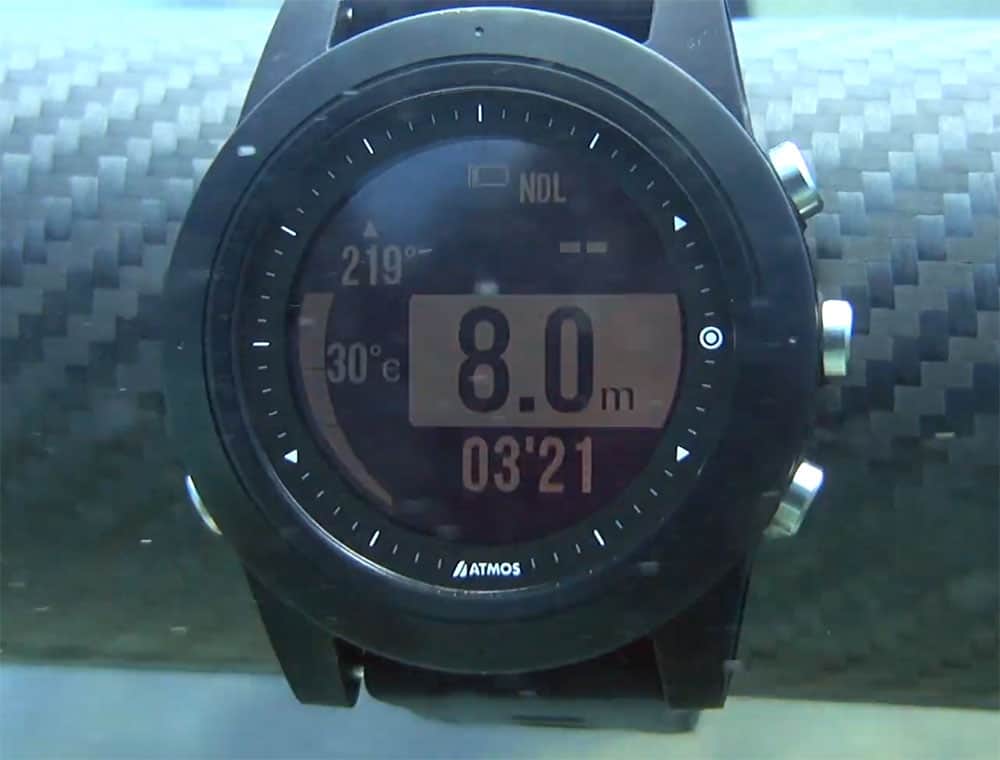The Atmos Mission One is a recreational dive computer targeting the mid-range market. It not only has a slim profile, but also has more functionality than other dive computers at a very reasonable price. In this review, we’ll talk about whether the flagship product from Taiwan-based manufacturer Atmos is the right one for you.
Dive computers have made many innovations since the early days. Back then when you thought of a dive computer you imagined a large, bulky device with a monochrome display. As time went on, some color LCD/OLED models started to enter the market. These devices were pricey and out of most beginners’ budgets.
As manufacturers improved their designs, more and more sleek and affordable dive computers became available, though most of these still use a monochrome LCD screen and rely on a button to activate the backlight. With the introduction of the Atmos Mission One, perhaps this indicates another shift in the market.
Atmos Mission One Overview
- IOS Smart Watch
- Dive Computer
- 4 Modes: Air|Nitrox|Freedive|Gauge
Atmos is a new company based out of Taiwan, and the Mission One appears to be their only product so far. Let’s see what their flagship product has to offer against dive computers from established companies like Cressi, Suunto, or Mares. Is the Atmos Mission One worth your money?
Appearance
The watch form factor of the Atmos Mission One is sleek and so far only available in black, with a white model soon to be released. The straps are made of silicone and also come in black, though you can replace the straps with colored ones which you have to buy separately.
Next, the Mission One sports a fiber reinforced case, with a stainless steel bezel sitting on top. Overall, the dive computer weighs 90 grams and sits comfortably (and fashionably) on your wrist.
Comfort and Fit
We appreciate the attention to detail Atmos has paid to the Mission One. For instance, the double watch strap keepers provide additional security. Freedivers who tie their dive watch to their neck weight during descent won’t worry about this one getting undone.
Furthermore, we like how one of the keepers includes a notch to secure it in place in the adjustment holes. These small details sometimes go unnoticed, but it is exactly the kind of attention to detail we like to see, particularly from a relatively unknown brand.
Additionally, the watch strap sticks have excellent grip and will not slide around on your wetsuit or wrist.
Navigation
The Mission One has 4 buttons to help you navigate the menu; three are located on the right side of the frame, and one is by its lonesome on the bottom left. We appreciate how far apart the buttons are so as to give you plenty of space to press the correct one and reduce errors even if you have thick gloves on.
In addition to having numerous buttons to help you navigate the interface, the menu system is intuitive and easy-to-use as well. Within just a few minutes we were able to comfortably navigate the interface as if we’ve had this dive watch for years.
First, the lone button on the bottom left acts as a back button. For the three buttons on the right, the top and bottom buttons let you scroll up and down the menu respectively, and the middle right button is the selection/confirmation button. Pressing the middle right button on the home screen takes you into the main menu structure with the following options:
- Setting
- Scuba (air/nitrox mode)
- Freedive (freediving mode)
- Gauge (gauge mode)
- Logbook
- Compass
So you would use the top right or bottom right buttons to scroll up or down. Once you’ve highlighted the setting you want, press the middle right button to confirm your selection. Press the back button on the bottom left if you’ve made a mistake or want to exit a mode. Pretty straightforward, right?
Dive Modes and Functionality
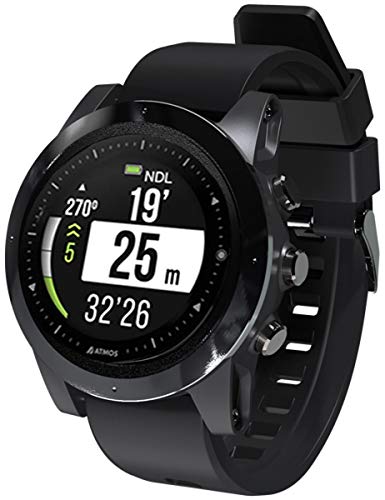
The Atmos Mission One is designed for recreational divers in mind. It only calculates air and nitrox mixes and does not provide support for other gases or trimix. The Mission One runs the Bühlmann decompression algorithm, which is similar to what Shearwater dive computers run.
You can adjust the conservatism levels, though we found that the default “MID” setting was the most balanced. Changing the conservatism to “LOW” made us uncomfortable because of how liberal the watch became. If you like to dive deep then this is perfect for you, though we prefer to err on the side of caution.
You can manually enter a dive mode by pressing the middle right button from the home screen, highlighting the dive mode (e.g. Scuba, Freedive, Gauge) and pressing the middle button again to enter. However, the dive mode can be activated automatically when submerged. You can change the depth at which it automatically activates within the dive settings.
The interface will change into the dive mode interface. The interface is simplistic and easy to read. The biggest, most prominent number that stands out is the depth reading. Above that is the no-decompression limit (NDL) reading and below that is the dive time.
One unique feature of the Atmos Mission One is its always-on compass. By holding down the middle right button you can turn on or turn off the compass mode. In this mode, headings can be marked and pressing the top right button can lock the heading. Pressing the bottom right button will remove the mark.
Next, directly to the left of the depth reading is an alternating display that changes between your rate of ascent or the water temperature.
Freediving Mode
Freedivers and spearfishers should pay attention to the Mission One’s freediving mode. We like how it has a “no fly” reminder similar to the Scuba mode. This is a great reminder that nitrogen accumulates in the body during deep freediving, and that one should not Scuba or fly afterwards. This level of attention to detail to safety and conservatism is appreciated.
When in freediving mode, the battery will drain significantly faster. We were able to manage approximately 5 dive sessions before we needed to recharge.
Audible and Visual Alarms
With 10 sets of depth alarms and 10 sets of time alarms that you can fully customize, the Atmos Mission One is perfect for training.
The warnings and alerts will also trigger to let you know about critical information such as low NDL, depth alarms, or if any deco stops are needed. The visual indicator flashes red and can temporarily obscure the dive time, which most of the time is not a critical piece of information.
One particular alarm to pay attention to is the surface interval alarm. It is basically an alarm that tells you when it is safe for you to perform another dive. The recommended surface interval time is just a suggestion, and it is up to the diver to decide when it is safe to do another dive. However, it is a good idea to wait out the Mission One’s surface interval timer at a minimum.
You can set the dive watch to use a combination of noise and vibration to give you warnings, in addition to the flashing warning on the screen. For instance, you can set it so that only the noise or the vibration will trigger, but both simultaneously will grab your attention for certain. We felt that the vibration is very strong and it is very noticeable even with a wetsuit on.
Display
Next, the Mission One has an impressive transflective color LCD display. What this means is that the screen is still visible in dim conditions or bright sunlight with the backlight on. Also, many dive computers are monochrome whereas the Mission One has color, which is a great addition.
You have the option to change the brightness level of the backlight as well as its duration (up to 60 seconds). The backlight can also be activated purely with wrist movements which is ideal for night dives or when you don’t have a free hand. All you need to do is twist your wrist and the motion sensor will detect the movement and activate the backlight.
The features described above are part of the reason why the Mission One is above other dive computers in comparable or higher price ranges. We really like the color LCD display and how you do not need to press any buttons to activate the backlight. These “little” advantages add up and are what make the Mission One stand out from the rest.
Logbook Memory
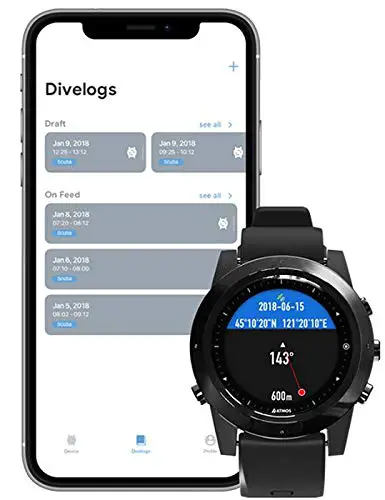
After you’ve finished diving, you can transfer your dive log to your Apple or Android device using the Atmos app. You can store up to 100 logs on the device’s memory. Transferring the data is straightforward, though we found the iPhone app to have more functionality than the Android app.
The Atmos app for Android devices only allows you to download the dive log with basic information such as air and water temperature, average and max depth, dive time, and the dive profile. On the other hand, the iPhone app also allows you to include more information like dive site notes (e.g. current, wave, visibility) and starting air and remaining air left.
Being able to analyze your dive profile is important not just for education, but also for safety reasons. Thus, we highly recommend you download the app from the Apple Story or Google Play. The app also allows syncing between devices via Bluetooth.
Perhaps in the future the Android version will reach parity with the iPhone versions, but right now the iPhone app has an advantage.
GPS
Another useful feature in the Mission One is the built-in GPS. Mark dive entry and exit coordinates by allowing the GPS icon to stop blinking before submerging underwater and after surfacing. The GPS functionality doesn’t work underwater and needs to have as little interference as possible above water. The Mission One also features a dive site guide that recommends nearby dive sites and lets you add custom ones to your list.
Watch Functionality
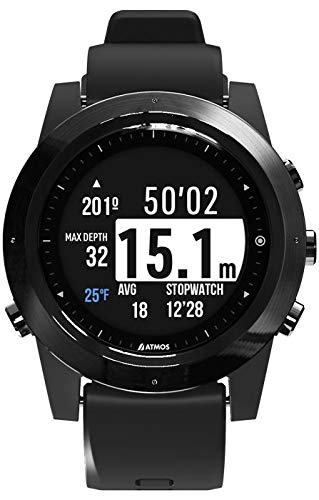
When you’re done with Scuba diving, the Atmos Mission One provides numerous watch functions so that it can be used as a daily watch. The design intention is clear if the watch form factor isn’t obvious enough.
The Mission One can receive notifications from your iPhone from various popular messaging apps like WeChat, WhatsApp, Facebook, etc. Unfortunately, Android users are currently unable to do the same. Press the top right button to display the notifications screen. Use the bottom right button to scroll through each notification.
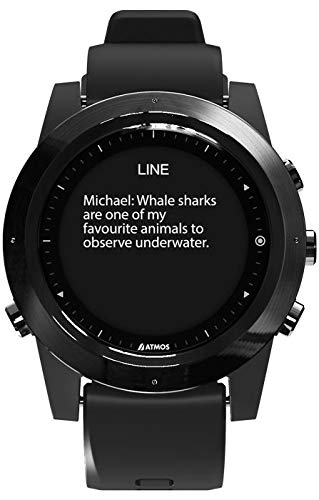
Battery Life
The battery life for the Mission One is approximately 40 hours in dive mode with minimal backlight usage, or 15 hours in dive mode with the backlight on the “mid” setting. In watch mode, the battery can last over two weeks depending on how often the backlight is on.
The battery status indicator is represented by a minimal 4 bar icon. We feel that Atmos should include a battery percentage display, since currently it is unable to tell you exactly how much battery is left “between” bars, e.g. is 51% and 75% battery life both represented by 3 bars, and it only drops to 2 bars when it reaches 50%? You can charge the Mission One with the USB cable and clip.
Atmos Mission One Review: The Verdict
- IOS Smart Watch
- Dive Computer
- 4 Modes: Air|Nitrox|Freedive|Gauge
Considering how Atmos is a brand new player in the dive computer market, we were impressed at the quality of the Mission One. As far as recreational dive computers under $500 go, this one has incredible value for the money. Here is a summary of the features we liked about the Mission One:
- Beautiful watch form factor with accompanying watch functionality lets the Mission One double as a daily watch outside of diving.
- Bluetooth pairing with smartphones to easily transfer dive logs.
- Phone notifications (currently only available for iOS).
- Color TFT display that is readable in dim or bright conditions.
- Always-on digital compass.
- Built-in surface GPS that can mark entry/exit points to record dive site coordinates.
- Dive log memory can store the dive data from your last 100 dives.
- Simplistic user interface that is easy to navigate with the 4 menu buttons.
- Vibration alerts (beeps can be turned off if you find them annoying).
- Hands-free, wrist activated backlight activation.
- Upgradeable firmware.
- Unbelievably low price for a dive computer with all of the features above.
We have a few minor complaints which we’ll address here. First, there’s obviously a preference for iOS instead of Android for the Atmos app. Functionality is limited in the Android version, such as a lack of the phone notification function whereas the iOS version supports this. The backlight could also be slightly brighter too. These are not deal-breakers, but they are something to keep in mind.
Furthermore, there is some functionality that we hope can make it into future versions of this dive computer. For example, the Mission One does not support air integration. Not all divers use this feature, but for technical or experienced divers, being able to view your essential data at a glance is crucial.
With that said, the Atmos Mission One is already jam-packed with great features like color display, built-in compass, GPS, Bluetooth connectivity, and of course all of the basics as well. For a sub-$500 dive computer, the value is nearly unbeatable. We can wholeheartedly recommend the Atmos Mission One to recreational divers that are looking to upgrade to a mid-range dive computer at a fair price point.
Photo: WolFang Digital
Last update on 2024-07-15 / Affiliate links / Images from Amazon Product Advertising API

